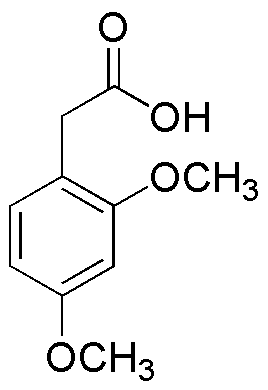2,4-Dimethoxyphenylacetic acid is widely utilized in research focused on:
- Pharmaceutical Development: This compound serves as a building block in the synthesis of various pharmaceuticals, particularly in the development of anti-inflammatory and analgesic drugs.
- Agricultural Chemistry: It is used in the formulation of herbicides, helping to enhance crop yield and manage weed populations effectively.
- Biochemical Research: Researchers employ this acid in studies related to enzyme inhibition and metabolic pathways, providing insights into biological processes.
- Cosmetic Formulations: The compound is incorporated into skincare products for its potential antioxidant properties, contributing to skin health and protection.
- Material Science: It is explored in the development of polymers and resins, offering improved durability and chemical resistance in various applications.
General Information
Properties
Safety and Regulations
Applications
2,4-Dimethoxyphenylacetic acid is widely utilized in research focused on:
- Pharmaceutical Development: This compound serves as a building block in the synthesis of various pharmaceuticals, particularly in the development of anti-inflammatory and analgesic drugs.
- Agricultural Chemistry: It is used in the formulation of herbicides, helping to enhance crop yield and manage weed populations effectively.
- Biochemical Research: Researchers employ this acid in studies related to enzyme inhibition and metabolic pathways, providing insights into biological processes.
- Cosmetic Formulations: The compound is incorporated into skincare products for its potential antioxidant properties, contributing to skin health and protection.
- Material Science: It is explored in the development of polymers and resins, offering improved durability and chemical resistance in various applications.
Documents
Safety Data Sheets (SDS)
The SDS provides comprehensive safety information on handling, storage, and disposal of the product.
Product Specification (PS)
The PS provides a comprehensive breakdown of the product’s properties, including chemical composition, physical state, purity, and storage requirements. It also details acceptable quality ranges and the product's intended applications.
Certificates of Analysis (COA)
Search for Certificates of Analysis (COA) by entering the products Lot Number. Lot and Batch Numbers can be found on a product’s label following the words ‘Lot’ or ‘Batch’.
*Catalog Number
*Lot Number
Certificates Of Origin (COO)
This COO confirms the country where the product was manufactured, and also details the materials and components used in it and whether it is derived from natural, synthetic, or other specific sources. This certificate may be required for customs, trade, and regulatory compliance.
*Catalog Number
*Lot Number
Safety Data Sheets (SDS)
The SDS provides comprehensive safety information on handling, storage, and disposal of the product.
DownloadProduct Specification (PS)
The PS provides a comprehensive breakdown of the product’s properties, including chemical composition, physical state, purity, and storage requirements. It also details acceptable quality ranges and the product's intended applications.
DownloadCertificates of Analysis (COA)
Search for Certificates of Analysis (COA) by entering the products Lot Number. Lot and Batch Numbers can be found on a product’s label following the words ‘Lot’ or ‘Batch’.
*Catalog Number
*Lot Number
Certificates Of Origin (COO)
This COO confirms the country where the product was manufactured, and also details the materials and components used in it and whether it is derived from natural, synthetic, or other specific sources. This certificate may be required for customs, trade, and regulatory compliance.


